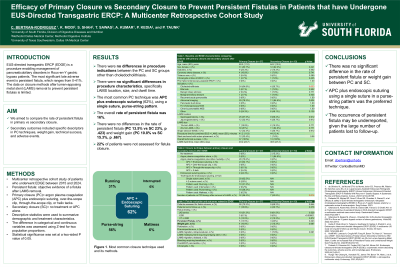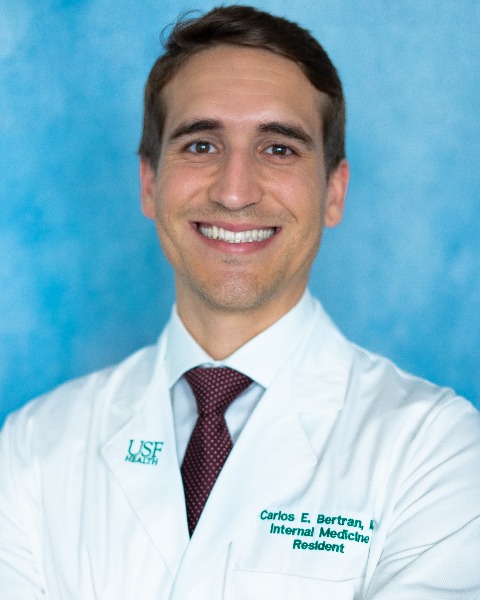Tuesday Poster Session
Category: Interventional Endoscopy
P4473 - Efficacy of Primary Closure vs Secondary Closure to Prevent Persistent Fistulas in Patients That Have Undergone EUS-Directed Transgastric ERCP: A Multicenter Retrospective Cohort Study
Tuesday, October 29, 2024
10:30 AM - 4:00 PM ET
Location: Exhibit Hall E

Has Audio

Carlos Bertran-Rodriguez, MD
University of South Florida
Tampa, FL
Presenting Author(s)
Carlos Bertran-Rodriguez, MD1, Kinnari Modi, DO2, Shawn Shah, MD3, Tarek Sawas, MD4, Prashant Kedia, MD, FACG2, Pushpak Taunk, MD1
1University of South Florida, Tampa, FL; 2Methodist Dallas Medical Center, Dallas, TX; 3University of Texas Southwestern, Dallas, TX; 4UT Southwestern, Coppell, TX
Introduction: EUS-directed transgastric ERCP (EDGE) is a procedure enabiling management of pancreaticobiliary disorders in Roux-en-Y gastric bypass patients. The most significant late adverse event is persistent fistula, which ranges from 0-41%. The data on closure methods after lumen-apposing metal stent (LAMS) removal to prevent persistent fistulas is limited.
Methods: This is a multicenter retrospective cohort study of patients who underwent EDGE between 2015 and 2023. We aimed to compare the rate of persistent fistula in primary vs secondary closure. Persistent fistula was defined as objective evidence of a fistula after LAMS removal. Primary closure (PC) included the application of argon plasma coagulation (APC) plus endoscopic suturing, over-the-scope clip, through-the-scope clip, or helix tacks. Secondary closure (SC) included either no treatment or APC alone. Secondary outcomes included weight gain, technical success, adverse events, and specific descriptors in PC techniques. Descriptive statistics were used to summarize demographic and treatment characteristics. The difference in categorical and continuous variables was assessed using Z-test for two population proportions. The threshold for statistical significance was set at a two-sided P value of 0.05.
Results: A total of 50 patients were identified. There were no differences in procedure indications between the PC and SC group, other than choledocholithiasis (PC 64.8% vs SC 30.7%, p .033). Importantly, there were no significant differences in procedure characteristics between the PC and SC group, specifically LAMS location, size and dwell time. The overall rate of persistent fistula was 16%. There were no differences in the rate of persistent fistula (PC 13.5% vs SC 23%, p .423) and weight gain (PC 10.8% vs SC 15.3%, p .667) between the two groups. The most common PC technique was APC plus endoscopic suturing (62%), using a single suture, purse-string pattern. Interestingly, 22% of patients were not assessed for fistula closure.
Discussion: There was no significant difference in the rate of persistent fistula or weight gain between primary or secondary closure in post-EDGE patients. In addition, the occurrence of persistent fistula may be underreported, given the large number of patients lost to follow-up. To our knowledge, this is the first multicenter study to evaluate the efficacy and outcomes of primary vs secondary closure of fistulas after EDGE.
Note: The table for this abstract can be viewed in the ePoster Gallery section of the ACG 2024 ePoster Site or in The American Journal of Gastroenterology's abstract supplement issue, both of which will be available starting October 27, 2024.
Disclosures:
Carlos Bertran-Rodriguez, MD1, Kinnari Modi, DO2, Shawn Shah, MD3, Tarek Sawas, MD4, Prashant Kedia, MD, FACG2, Pushpak Taunk, MD1. P4473 - Efficacy of Primary Closure vs Secondary Closure to Prevent Persistent Fistulas in Patients That Have Undergone EUS-Directed Transgastric ERCP: A Multicenter Retrospective Cohort Study, ACG 2024 Annual Scientific Meeting Abstracts. Philadelphia, PA: American College of Gastroenterology.
1University of South Florida, Tampa, FL; 2Methodist Dallas Medical Center, Dallas, TX; 3University of Texas Southwestern, Dallas, TX; 4UT Southwestern, Coppell, TX
Introduction: EUS-directed transgastric ERCP (EDGE) is a procedure enabiling management of pancreaticobiliary disorders in Roux-en-Y gastric bypass patients. The most significant late adverse event is persistent fistula, which ranges from 0-41%. The data on closure methods after lumen-apposing metal stent (LAMS) removal to prevent persistent fistulas is limited.
Methods: This is a multicenter retrospective cohort study of patients who underwent EDGE between 2015 and 2023. We aimed to compare the rate of persistent fistula in primary vs secondary closure. Persistent fistula was defined as objective evidence of a fistula after LAMS removal. Primary closure (PC) included the application of argon plasma coagulation (APC) plus endoscopic suturing, over-the-scope clip, through-the-scope clip, or helix tacks. Secondary closure (SC) included either no treatment or APC alone. Secondary outcomes included weight gain, technical success, adverse events, and specific descriptors in PC techniques. Descriptive statistics were used to summarize demographic and treatment characteristics. The difference in categorical and continuous variables was assessed using Z-test for two population proportions. The threshold for statistical significance was set at a two-sided P value of 0.05.
Results: A total of 50 patients were identified. There were no differences in procedure indications between the PC and SC group, other than choledocholithiasis (PC 64.8% vs SC 30.7%, p .033). Importantly, there were no significant differences in procedure characteristics between the PC and SC group, specifically LAMS location, size and dwell time. The overall rate of persistent fistula was 16%. There were no differences in the rate of persistent fistula (PC 13.5% vs SC 23%, p .423) and weight gain (PC 10.8% vs SC 15.3%, p .667) between the two groups. The most common PC technique was APC plus endoscopic suturing (62%), using a single suture, purse-string pattern. Interestingly, 22% of patients were not assessed for fistula closure.
Discussion: There was no significant difference in the rate of persistent fistula or weight gain between primary or secondary closure in post-EDGE patients. In addition, the occurrence of persistent fistula may be underreported, given the large number of patients lost to follow-up. To our knowledge, this is the first multicenter study to evaluate the efficacy and outcomes of primary vs secondary closure of fistulas after EDGE.
Note: The table for this abstract can be viewed in the ePoster Gallery section of the ACG 2024 ePoster Site or in The American Journal of Gastroenterology's abstract supplement issue, both of which will be available starting October 27, 2024.
Disclosures:
Carlos Bertran-Rodriguez indicated no relevant financial relationships.
Kinnari Modi indicated no relevant financial relationships.
Shawn Shah indicated no relevant financial relationships.
Tarek Sawas indicated no relevant financial relationships.
Prashant Kedia: Boston Scientific, Olympus, Medtronic – Consultant.
Pushpak Taunk: Boston Scientific – Consultant. Neptune Medical – Consultant.
Carlos Bertran-Rodriguez, MD1, Kinnari Modi, DO2, Shawn Shah, MD3, Tarek Sawas, MD4, Prashant Kedia, MD, FACG2, Pushpak Taunk, MD1. P4473 - Efficacy of Primary Closure vs Secondary Closure to Prevent Persistent Fistulas in Patients That Have Undergone EUS-Directed Transgastric ERCP: A Multicenter Retrospective Cohort Study, ACG 2024 Annual Scientific Meeting Abstracts. Philadelphia, PA: American College of Gastroenterology.

